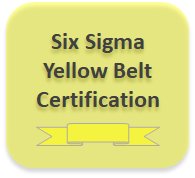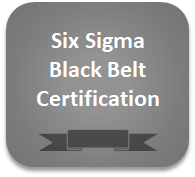Six Sigma Certifications
Common Certification Types
Six Sigma certifications are widely available. There are different requirements depending on the type of certification. And within these types there are differences in the lengths of time invested, deliverables, and exams.
Six-Sigma-Material.com is an informational site designed to assist project managers and prepare for certification exams. This includes:
Six-Sigma-Material.com does offer practice certification problems. Click here to learn more. There are 180+ sample problems and numerous examples throughout this site that will help prepare for a certification exam. These are available to subscribers.
This website has thousands of detailed pages that can undoubtedly help you succeed as a Six Sigma project manager at any "belt" level and pass any level certification exam.
Levels of Six Sigma Certification
Certifications are available at many levels and the "belt" hierarchy has evolved over the years. The most common Six Sigma certifications in increasing order of difficulty are:
Yellow Belt Certification
Yellow Belts typically participate as a team member on a Six Sigma project. They help with process improvements and receive training on the principles and basic statistics.
Being a Yellow Belt (usually like a White and Green Belt) is normally not their full time job. But Yellow Belts are often called upon more often than White Belts to participate on team and may be on more than one project at a time.
Certification process will provide basic knowledge of the Six Sigma principle and basic statistics. The training and certification process are usually completed within two days and consist of 12-20 training hours plus an exam.
Because this is the second step in the belt hierarchy, these people may be viewed as future leaders in the company. They can also be Managers, Supervisors, or employees that have an responsibility to improve quality or process performance.
This is the first level of "belts" that are given formal introduction into statistical analysis and may be required to learn the basic in a statistical software program.
CLICK HERE to review the Yellow Belt training and certification options.
Green Belt Certification
Green Belts require an understanding of the Lean principles and a basic understanding of statistical analysis. The goals of a Green Belt are shifting the performance to a desired target and reducing the variation of a process.
They usually support Black Belts and are not normally employed as full-time Green Belts. They may also mentor White Belts and Yellow Belts and lead teams with other Green Belts.
This is the first level of "belts" that could lead a project on their own. They usually won't have more than one project to lead at a time but they could be a participant on other teams while leading their own.
Green Belt projects are usually smaller in scope than Black Belt projects. However, they are often expected to be completed within a shorter time span.
These certifications programs are less rigorous than Black Belt program. Certification programs typically vary from 80 – 160 hours of coursework plus an exam.
CLICK HERE to review the Green Belt certification options.
Black Belt Certification
Black Belts will require a thorough understanding of the Lean principles and statistical analysis. Their goal are to shift the performance to a desired target and reduce the variation of process. They usually work as full-time Black Belts and mentor Green Belts and other lower level Belts.
Black Belts often provide training and may be involved in creating new material for instructing new Black Belts and Green Belts. These certifications programs are more rigorous than Green Belt program but less than Master Black Belt programs.
Their projects tend to be of higher value and complexity than a Green Belt project. Certification programs typically very from 160 hrs – 360 hrs of coursework. May require proof of project completion, examination, and references.
CLICK HERE for review the Black Belt certification options.
Master Black Belt Certification
Master Black Belts (MBB) are subject matter experts of the Lean principles and have a solid understanding of statistical analysis and advanced statistical concepts.
They usually work as full-time Master Black Belts and devote a significant amount of time mentoring Black Belts, Green Belts, Yellow Belts, and White Belts. These certifications programs are the most rigorous and involve advanced statistical knowledge.
Their projects tend to focus on fundamental change and direction for a company. Master Black Belts also develop materials, certification programs, and conduct training and provide overall direction for the Six Sigma program.
Master Black Belts will have advanced statistical expertise and are normally leaders of the company. The certification process take several weeks, usually requires proven project execution (at least one project) and proven ability to lead change.
MBB's are not just stellar performers within the methodology, they are leaders, and knowledgeable in other areas such as finance, team building, motivational techniques, and presentation skills.
Project Management Certification
A primary component of the job for a Six Sigma GB or BB has to do with effective Project Management skills. Change is constant and change is difficult...or someone else would have already done it. Creating a true fundamental shift in the performance of a process INVOLVES people and the culture they work within.
Staying on task, being organized, understanding critical path elements are not taught in most Six Sigma courses. Becoming an effective change agent can be very difficult for some highly technical people. Knowledge builds confidence and this builds trust.
From the onset of a project, the moment you begin to lead your team they are developing a sense of trust and credibility in you, and this can create strong synergy to complement your technical Six Sigma skills. Or it can work against all the hard work and knowledge you have on the Six Sigma principles, statistics, tools, etc.
The team does not care how much you know, until they know how much you care.
Learn more about Project Management Tools.
Get full access to all pages of this website
Templates, Statistics Tables, and Calculators
Site Membership
Click for a Password
to access entire site
Six Sigma
Templates & Calculators
Six Sigma Modules
The following are available
Click Here
Green Belt Program (1,000+ Slides)
Basic Statistics
Cost of Quality
SPC
Process Mapping
Capability Studies
MSA
Cause & Effect Matrix
FMEA
Multivariate Analysis
Central Limit Theorem
Confidence Intervals
Hypothesis Testing
T Tests
1-Way ANOVA
Chi-Square
Correlation and Regression
Control Plan
Kaizen
MTBF and MTTR
Project Pitfalls
Error Proofing
Effective Meetings
OEE
Takt Time
Line Balancing
Practice Exam
... and more





